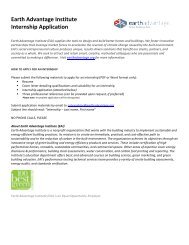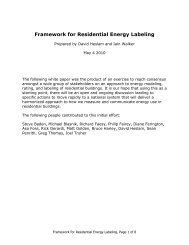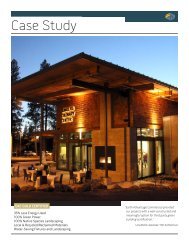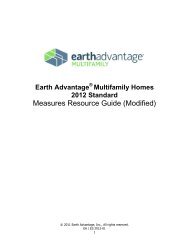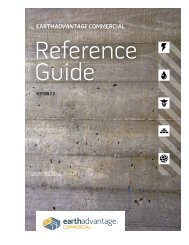EA New Homes Measures Guide - Earth Advantage
EA New Homes Measures Guide - Earth Advantage
EA New Homes Measures Guide - Earth Advantage
You also want an ePaper? Increase the reach of your titles
YUMPU automatically turns print PDFs into web optimized ePapers that Google loves.
2012 <strong>Earth</strong> <strong>Advantage</strong> Residential<br />
<strong>Measures</strong> Resource <strong>Guide</strong><br />
4.2.7<br />
Alternate Cooling System: No capacity to use refrigerants<br />
Energy<br />
Health<br />
Materials<br />
Water<br />
0 0 0 1 0<br />
Description: Employ cooling methods that do not use refrigerants. This may be a ceiling fan, evaporative cooler, whole house fan, night<br />
ventilation system, or building design elements (such as shades or trellises). If a forced-air heating system is installed, it must have no<br />
accommodation for future addition of air conditioning equipment, including the installation of refrigerant lines. In other words, the HVAC<br />
system cannot be "AC ready".<br />
Land<br />
Benefit: Residential cooling is becoming common in new home construction, even though mechanical cooling may not be needed to<br />
maintain comfort. Many strategies exist to cool homes without the high energy consumption of typical refrigeration based cooling. By using<br />
a non-refrigerant system there are no ozone-depleting, greenhouse gasses (HCFCs) released into the atmosphere.<br />
Verification: <strong>EA</strong> Rater will identify the alternative cooling method and record a short description in the verification records. It may be<br />
necessary to contact the builder for details.<br />
4.2.8<br />
Gas Furnace and A/C Commissioning<br />
Energy<br />
Materials<br />
Water<br />
1 1 0 0 0<br />
Description: Follow the HVAC equipment manufacturer's installation and start up procedure. Meet manufacturer's specifications for these<br />
items:<br />
<br />
Measure static pressure of the supply and return ducting. Then calculate overall static pressure on HVAC system.<br />
<br />
Measure air temperature in both supply and return ducting. Then calculate air flow using the temperature delta or a Trueflow plate. <br />
<br />
For gas furnaces, measure gas pressure at the manifold; adjust for local gas pressure and elevation.<br />
<br />
Check combustion efficiency using a flue gas analyzer.<br />
<br />
For air conditioners, check refrigerant charge.<br />
<br />
Clean interior of furnace/air-handler to remove construction dust and debris.<br />
Health<br />
Land<br />
Benefit: HVAC systems work most efficiently when installed to manufacturer's specifications. This requires following written installation<br />
procedures and testing.<br />
Verification: HVAC professional shall provide commissioning documentation that the HVAC system meets the manufacturer's specifications.<br />
4.3 Ductwork<br />
Page 33 of 70



